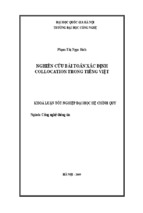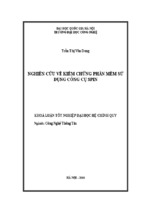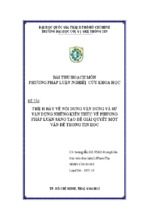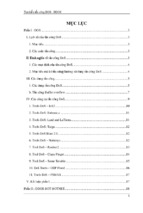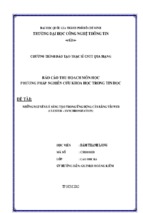44373.book Page iii Thursday, January 18, 2007 9:18 AM
CEH
™
Official
Certified Ethical Hacker
Review Guide
Kimberly Graves
Wiley Publishing, Inc.
44373.book Page ii Thursday, January 18, 2007 9:18 AM
44373.book Page i Thursday, January 18, 2007 9:18 AM
CEH
™
Official
Certified Ethical Hacker
Review Guide
44373.book Page ii Thursday, January 18, 2007 9:18 AM
44373.book Page iii Thursday, January 18, 2007 9:18 AM
CEH
™
Official
Certified Ethical Hacker
Review Guide
Kimberly Graves
Wiley Publishing, Inc.
44373.book Page iv Thursday, January 18, 2007 9:18 AM
Acquisitions and Development Editor: Jeff Kellum
Technical Editor: Sondra Schneider
Production Editor: Rachel Meyers
Copy Editor: Tiffany Taylor
Production Manager: Tim Tate
Vice President and Executive Group Publisher: Richard Swadley
Vice President and Executive Publisher: Joseph B. Wikert
Vice President and Publisher: Neil Edde
Media Project Supervisor: Laura Atkinson
Media Development Specialist: Steve Kudirka
Media Quality Assurance: Angie Denny
Book Designers: Judy Fung and Bill Gibson
Compositor: Craig Woods, Happenstance Type-O-Rama
Proofreader: Nancy Riddiough
Indexer: Ted Laux
Anniversary Logo Design: Richard Pacifico
Cover Designer: Ryan Sneed
Copyright © 2007 by Wiley Publishing, Inc., Indianapolis, Indiana
Published simultaneously in Canada
ISBN-13: 978-0-7821-4437-6
No part of this publication may be reproduced, stored in a retrieval system or transmitted in any form or by any
means, electronic, mechanical, photocopying, recording, scanning or otherwise, except as permitted under Sections
107 or 108 of the 1976 United States Copyright Act, without either the prior written permission of the Publisher, or
authorization through payment of the appropriate per-copy fee to the Copyright Clearance Center, 222 Rosewood
Drive, Danvers, MA 01923, (978) 750-8400, fax (978) 646-8600. Requests to the Publisher for permission should
be addressed to the Legal Department, Wiley Publishing, Inc., 10475 Crosspoint Blvd., Indianapolis, IN 46256,
(317) 572-3447, fax (317) 572-4355, or online at http://www.wiley.com/go/permissions.
Limit of Liability/Disclaimer of Warranty: The publisher and the author make no representations or warranties with
respect to the accuracy or completeness of the contents of this work and specifically disclaim all warranties, including
without limitation warranties of fitness for a particular purpose. No warranty may be created or extended by sales
or promotional materials. The advice and strategies contained herein may not be suitable for every situation. This
work is sold with the understanding that the publisher is not engaged in rendering legal, accounting, or other professional services. If professional assistance is required, the services of a competent professional person should be
sought. Neither the publisher nor the author shall be liable for damages arising herefrom. The fact that an organization or Website is referred to in this work as a citation and/or a potential source of further information does not
mean that the author or the publisher endorses the information the organization or Website may provide or recommendations it may make. Further, readers should be aware that Internet Websites listed in this work may have
changed or disappeared between when this work was written and when it is read.
For general information on our other products and services or to obtain technical support, please contact our Customer
Care Department within the U.S. at (800) 762-2974, outside the U.S. at (317) 572-3993 or fax (317) 572-4002.
Wiley also publishes its books in a variety of electronic formats. Some content that appears in print may not be
available in electronic books.
Library of Congress Cataloging-in-Publication Data is available from the publisher.
TRADEMARKS: Wiley, the Wiley logo, and the Sybex logo are trademarks or registered trademarks of John Wiley
& Sons, Inc. and/or its affiliates, in the United States and other countries, and may not be used without written
permission. EC-Council, the EC-Council logo, and CEH are trademarks or registered trademarks of EC-Council.
All rights reserved. All other trademarks are the property of their respective owners. Wiley Publishing, Inc., is not
associated with any product or vendor mentioned in this book.
10 9 8 7 6 5 4 3 2 1
44373.book Page v Thursday, January 18, 2007 9:18 AM
Contents at a Glance
Introduction
xv
Chapter 1
Introduction to Ethical Hacking, Ethics, and Legality
1
Chapter 2
Footprinting and Social Engineering
19
Chapter 3
Scanning and Enumeration
41
Chapter 4
System Hacking
67
Chapter 5
Trojans, Backdoors, Viruses, and Worms
91
Chapter 6
Sniffers
107
Chapter 7
Denial of Service and Session Hijacking
119
Chapter 8
Hacking Web Servers, Web Application Vulnerabilities,
and Web-Based Password Cracking Techniques
137
Chapter 9
SQL Injection and Buffer Overflows
151
Chapter 10
Wireless Hacking
159
Chapter 11
Physical Security
169
Chapter 12
Linux Hacking
177
Chapter 13
Evading IDSs, Honeypots, and Firewalls
187
Chapter 14
Cryptography
195
Chapter 15
Penetration Testing Methodologies
203
Glossary
213
Index
225
44373.book Page vi Thursday, January 18, 2007 9:18 AM
44373.book Page vii Thursday, January 18, 2007 9:18 AM
Contents
Introduction
Chapter
Chapter
xv
1
2
Introduction to Ethical Hacking, Ethics,
and Legality
1
Understanding Ethical Hacking Terminology
Identifying Different Types of Hacking Technologies
Understanding the Different Phases Involved in Ethical
Hacking and Listing the Five Stages of Ethical Hacking
Phase 1: Passive and Active Reconnaissance
Phase 2: Scanning
Phase 3: Gaining Access
Phase 4: Maintaining Access
Phase 5: Covering Tracks
What Is Hacktivism?
Listing Different Types of Hacker Classes
Ethical Hackers and Crackers—Who Are They?
What Do Ethical Hackers Do?
Goals Attackers Try to Achieve
Security, Functionality, and Ease of Use Triangle
Defining the Skills Required to Become an Ethical Hacker
What Is Vulnerability Research?
Describing the Ways to Conduct Ethical Hacking
Creating a Security Evaluation Plan
Types of Ethical Hacks
Testing Types
Ethical Hacking Report
Understanding the Legal Implications of Hacking
Understanding 18 U.S.C. § 1029 and 1030 U.S. Federal Law
Exam Essentials
Review Questions
Answers to Review Questions
2
3
4
5
5
5
6
6
6
6
7
8
8
9
10
10
11
11
12
12
13
13
14
14
16
18
Footprinting and Social Engineering
19
Footprinting
Define the Term Footprinting
Describe the Information Gathering Methodology
Describe Competitive Intelligence
Understand DNS Enumeration
Understand Whois and ARIN Lookups
Identify Different Types of DNS Records
Understand How Traceroute Is Used in Footprinting
20
20
21
22
23
24
27
28
44373.book Page viii Thursday, January 18, 2007 9:18 AM
viii
Contents
Chapter
3
Understand How E-Mail Tracking Works
Understand How Web Spiders Work
Exam Essentials
Social Engineering
What Is Social Engineering?
What Are the Common Types Of Attacks?
Understand Insider Attacks
Understand Identity Theft
Describe Phishing Attacks
Understand Online Scams
Understand URL Obfuscation
Social-Engineering Countermeasures
Exam Essentials
Review Questions
Answers to Review Questions
29
29
29
30
30
32
33
33
34
34
35
35
36
37
40
Scanning and Enumeration
41
Scanning
Define the Terms Port Scanning, Network Scanning,
and Vulnerability Scanning
Understand the CEH Scanning Methodology
Understand Ping Sweep Techniques
Understand Nmap Command Switches
Understand SYN, Stealth, XMAS, NULL, IDLE,
and FIN Scans
List TCP Communication Flag Types
Understand War-Dialing Techniques
Understand Banner Grabbing and OS Fingerprinting
Techniques
Understand How Proxy Servers Are Used in Launching
an Attack
How Do Anonymizers Work?
Understand HTTP Tunneling Techniques
Understand IP Spoofing Techniques
Exam Essentials
Enumeration
What Is Enumeration?
What Is Meant by Null Sessions?
What Is SNMP Enumeration?
Windows 2000 DNS Zone Transfer
What Are the Steps Involved in Performing Enumeration?
Exam Essentials
Review Questions
Answers to Review Questions
42
42
43
44
46
48
49
51
52
53
53
54
54
55
55
56
56
58
59
60
60
62
66
44373.book Page ix Thursday, January 18, 2007 9:18 AM
Contents
Chapter
Chapter
4
5
ix
System Hacking
67
Understanding Password-Cracking Techniques
Understanding the LanManager Hash
Cracking Windows 2000 Passwords
Redirecting the SMB Logon to the Attacker
SMB Redirection
SMB Relay MITM Attacks and Countermeasures
NetBIOS DoS Attacks
Password-Cracking Countermeasures
Understanding Different Types of Passwords
Passive Online Attacks
Active Online Attacks
Offline Attacks
Nonelectronic Attacks
Understanding Keyloggers and Other Spyware Technologies
Understand Escalating Privileges
Executing Applications
Buffer Overflows
Understanding Rootkits
Planting Rootkits on Windows 2000 and XP Machines
Rootkit Embedded TCP/IP Stack
Rootkit Countermeasures
Understanding How to Hide Files
NTFS File Streaming
NTFS Stream Countermeasures
Understanding Steganography Technologies
Understanding How to Cover Your Tracks and Erase Evidence
Disabling Auditing
Clearing the Event Log
Exam Essentials
Review Questions
Answers to Review Questions
68
69
70
70
71
71
72
72
74
74
75
77
78
78
79
80
80
81
81
82
82
83
83
83
84
85
85
86
86
87
89
Trojans, Backdoors, Viruses, and Worms
91
Trojans and Backdoors
What Is a Trojan?
What Is Meant by Overt and Covert Channels?
List the Different Types of Trojans
How Do Reverse-Connecting Trojans Work?
Understand How the Netcat Trojan Works
What Are the Indications of a Trojan Attack?
What Is Meant by “Wrapping”?
Trojan Construction Kit and Trojan Makers
92
93
94
94
94
96
97
97
97
44373.book Page x Thursday, January 18, 2007 9:18 AM
x
Contents
Chapter
Chapter
6
7
What Are the Countermeasure Techniques in
Preventing Trojans?
Understand Trojan-Evading Techniques
System File Verification Subobjective to
Trojan Countermeasures
Viruses and Worms
Understand the Difference between a Virus and a Worm
Understand the Types of Viruses
Understand Antivirus Evasion Techniques
Understand Virus Detection Methods
Exam Essentials
Review Questions
Answers to Review Questions
99
99
99
100
101
101
101
103
106
Sniffers
107
Understand the Protocols Susceptible to Sniffing
Understand Active and Passive Sniffing
Understand ARP Poisoning
Understand Ethereal Capture and Display Filters
Understand MAC Flooding
Understand DNS Spoofing Techniques
Describe Sniffing Countermeasures
Exam Essentials
Review Questions
Answers to Review Questions
108
109
110
110
111
111
113
114
115
117
Denial of Service and Session Hijacking
119
Denial of Service
Understand the Types of DoS Attacks
Understand How DDoS Attacks Work
Understand How BOTs/BOTNETs Work
What Is a “Smurf” Attack?
What Is “SYN” Flooding?
Describe the DoS/DDoS Countermeasures
Session Hijacking
Understand Spoofing vs. Hijacking
List the Types of Session Hijacking
Understand Sequence Prediction
What Are the Steps in Performing Session Hijacking?
Describe How You Would Prevent Session Hijacking
Exam Essentials
Review Questions
Answers to Review Questions
98
98
120
120
122
123
124
124
124
125
125
126
126
128
129
130
131
135
44373.book Page xi Thursday, January 18, 2007 9:18 AM
Contents
Chapter
8
Hacking Web Servers, Web Application
Vulnerabilities, and Web-Based Password
Cracking Techniques
Hacking Web Servers
List the Types of Web Server Vulnerabilities
Understand the Attacks against Web Servers
Understand IIS Unicode Exploits
Understand Patch Management Techniques
Describe Web Server Hardening Methods
Web Application Vulnerabilities
Understanding How Web Applications Work
Objectives of Web Application Hacking
Anatomy of an Attack
Web Application Threats
Understand Google Hacking
Understand Web Application Countermeasures
Web-Based Password Cracking Techniques
List the Authentication Types
What Is a Password Cracker?
How Does a Password Cracker Work?
Understand Password Attacks: Classification
Understand Password-Cracking Countermeasures
Exam Essentials
Review Questions
Answers to Review Questions
Chapter
9
SQL Injection and Buffer Overflows
SQL Injection
What Is SQL Injection?
Understand the Steps to Conduct SQL Injection
Understand SQL Server Vulnerabilities
Describe SQL Injection Countermeasures
Buffer Overflows
Identify the Different Types of Buffer Overflows
and Methods of Detection
Overview of Stack-Based Buffer Overflows
Overview of Buffer Overflow Mutation Techniques
Exam Essentials
Review Questions
Answers to Review Questions
xi
137
138
138
139
139
140
140
141
141
142
142
142
143
143
144
144
144
144
145
145
145
147
149
151
152
152
152
153
153
154
154
154
155
155
156
158
44373.book Page xii Thursday, January 18, 2007 9:18 AM
xii
Contents
Chapter
10
Wireless Hacking
Overview of WEP, WPA Authentication Mechanisms,
and Cracking Techniques
Overview of Wireless Sniffers and Locating SSIDs,
MAC Spoofing
Understand Rogue Access Points
Understand Wireless Hacking Techniques
Describe the Methods Used to Secure Wireless Networks
Exam Essentials
Review Questions
Answers to Review Questions
Chapter
11
Physical Security
Physical Security Breach Incidents
Understanding Physical Security
What Is the Need for Physical Security?
Who Is Accountable for Physical Security?
Factors Affecting Physical Security
Exam Essentials
Review Questions
Answers to Review Questions
Chapter
Chapter
12
13
Linux Hacking
14
160
162
163
163
164
164
165
167
169
170
171
171
172
172
172
174
176
177
Linux Basics
Understand How to Compile a Linux Kernel
Understand GCC Compilation Commands
Understand How to Install Linux Kernel Modules
Understand Linux Hardening Methods
Exam Essentials
Review Questions
Answers to Review Questions
178
179
180
180
181
182
183
185
Evading IDSs, Honeypots, and Firewalls
187
List the Types of Intrusion Detection Systems and
Evasion Techniques
List the Firewall Types and Honeypot Evasion Techniques
Exam Essentials
Review Questions
Answers to Review Questions
Chapter
159
Cryptography
Overview of Cryptography and Encryption Techniques
Describe How Public and Private Keys Are Generated
188
189
191
192
194
195
196
197
44373.book Page xiii Thursday, January 18, 2007 9:18 AM
Contents
Overview of the MD5, SHA, RC4, RC5, and
Blowfish Algorithms
Exam Essentials
Review Questions
Answers to Review Questions
Chapter
15
Penetration Testing Methodologies
Defining Security Assessments
Overview of Penetration Testing Methodologies
List the Penetration Testing Steps
Overview of the Pen-Test Legal Framework
List the Automated Penetration Testing Tools
Overview of the Pen-Test Deliverables
Exam Essentials
Review Questions
Answers to Review Questions
Glossary
Index
xiii
197
198
199
201
203
204
204
205
206
207
208
208
209
211
213
225
44373.book Page xiv Thursday, January 18, 2007 9:18 AM
44373.book Page xv Thursday, January 18, 2007 9:18 AM
Introduction
The Certified Ethical Hacker (CEH) exam was developed by the International Council of
E-Commerce Consultants (EC-Council) to provide an industry-wide means of certifying the
competency of security professionals. The CEH certification is granted to those who have
attained the level of knowledge and troubleshooting skills needed to provide capable support
in the field of computer and network security.
The CEH exam is periodically updated to keep the certification applicable to the most
recent hardware and software. This is necessary because a CEH must be able to work on the
latest equipment. The most recent revisions to the objectives—and to the whole program—
were enacted in 2006 and are reflected in this book.
What Is CEH Certification?
The CEH certification was created to offer a wide-ranging certification, in the sense that
it’s intended to certify competence with many different makers/vendors. This certification is
designed for security officers, auditors, security professionals, site administrators, and anyone
who deals with the security of the network infrastructure on a day-to-day basis.
The goal of ethical hackers is to help organizations take preemptive measures against malicious attacks by attacking systems themselves, all the while staying within legal limits. This
philosophy stems from the proven practice of trying to catch a thief by thinking like a thief.
As technology advances organizations increasingly depend on technology, and information
assets have evolved into critical components of survival.
You need to pass only a single exam to become a CEH. But obtaining this certification doesn’t
mean you can provide services to a company—this is just the first step. By obtaining your CEH
certification, you’ll be able to obtain more experience, build on your interest in networks, and
subsequently pursue more complex and in-depth network knowledge and certifications.
For the latest exam pricing and updates to the registration procedures, call either Thomson
Prometric at (866) 776-6387 or (800) 776-4276, or Pearson VUE at (877) 680-3926. You
can also go to either www.2test.com or www.prometric.com (for Thomson Prometric) or
www.vue.com (for Pearson VUE) for additional information or to register online. If you have
further questions about the scope of the exams or related EC-Council programs, refer to the
EC-Council website at www.eccouncil.org.
Who Should Buy This Book?
CEH: Official Certified Ethical Hacker Review Guide is designed to be a succinct, portable
exam review guide that can be used either in conjunction with a more complete study program,
computer-based training courseware, or classroom/lab environment, or as an exam review tool
for those want to brush up before taking the exam. It isn’t our goal to give away the answers,
but rather to identify those topics on which you can expect to be tested.
44373.book Page xvi Thursday, January 18, 2007 9:18 AM
xvi
Introduction
If you want to become a CEH, this book is definitely what you need. However, if you just want
to attempt to pass the exam without really understanding the basics of ethical hacking, this guide
isn’t for you. It’s written for people who want to create a foundation of the skills and knowledge
necessary to pass the exam, and then take what they learned and apply it to the real world.
How to Use This Book and the CD
We’ve included several testing features in the book and on the CD-ROM. These tools will help
you retain vital exam content as well as prepare to sit for the actual exam:
Chapter Review Questions To test your knowledge as you progress through the book, there
are review questions at the end of each chapter. As you finish each chapter, answer the review
questions and then check your answers—the correct answers appear on the page following the
last review question. You can go back to reread the section that deals with each question you
got wrong to ensure that you answer correctly the next time you’re tested on the material.
Electronic Flashcards You’ll find flashcard questions on the CD for on-the-go review. These
are short questions and answers, just like the flashcards you probably used to study in school.
You can answer them on your PC or download them onto a Palm device for quick and convenient reviewing.
Test Engine The CD also contains the Sybex Test Engine. Using this custom test engine, you
can identify weak areas up front and then develop a solid studying strategy using each of these
robust testing features. Our thorough readme file will walk you through the quick, easy installation process.
In addition to taking the chapter review questions, you’ll find sample exams. Take these practice exams just as if you were taking the actual exam (without any reference material). When
you’ve finished the first exam, move on to the next one to solidify your test-taking skills. If you
get more than 90 percent of the answers correct, you’re ready to take the certification exam.
Glossary of Terms in PDF The CD-ROM contains a useful Glossary of Terms in PDF
(Adobe Acrobat) format so you can easily read it on any computer. If you have to travel and
brush up on any key terms, and you have a laptop with a CD-ROM drive, you can do so with
this resource.
Tips for Taking the CEH Exam
Here are some general tips for taking your exam successfully:
�
Bring two forms of ID with you. One must be a photo ID, such as a driver’s license. The
other can be a major credit card or a passport. Both forms must include a signature.
�
Arrive early at the exam center so you can relax and review your study materials, particularly tables and lists of exam-related information.
�
Read the questions carefully. Don’t be tempted to jump to an early conclusion. Make sure
you know exactly what the question is asking.
44373.book Page xvii Thursday, January 18, 2007 9:18 AM
Introduction
xvii
�
Don’t leave any unanswered questions. Unanswered questions are scored against you.
�
There will be questions with multiple correct responses. When there is more than one correct answer, a message at the bottom of the screen will prompt you to either “Choose
two” or “Choose all that apply.” Be sure to read the messages displayed to know how
many correct answers you must choose.
�
When answering multiple-choice questions you’re not sure about, use a process of elimination to get rid of the obviously incorrect answers first. Doing so will improve your odds
if you need to make an educated guess.
�
On form-based tests (non-adaptive), because the hard questions will eat up the most time,
save them for last. You can move forward and backward through the exam.
�
For the latest pricing on the exams and updates to the registration procedures, visit
EC-Council’s website at www.eccouncil.org.
The CEH Exam Objectives
At the beginning of each chapter in this book, we have included the complete listing of the
CEH objectives as they appear on EC-Council’s website. These are provided for easy reference
and to assure you that you are on track with the objectives.
Exam objectives are subject to change at any time without prior notice and
at EC-Council’s sole discretion. Please visit the CEH Certification page of
EC-Council’s website ( www.eccouncil.org/312-50.htm) for the most current
listing of exam objectives.
Ethics and Legality
�
Understand ethical hacking terminology.
�
Define the job role of an ethical hacker.
�
Understand the different phases involved in ethical hacking.
�
Identify different types of hacking technologies.
�
List the five stages of ethical hacking.
�
What is hacktivism?
�
List different types of hacker classes.
�
Define the skills required to become an ethical hacker.
�
What is vulnerability research?
�
Describe the ways of conducting ethical hacking.
�
Understand the legal implications of hacking.
�
Understand 18 U.S.C. § 1030 US Federal Law.
- Xem thêm -




